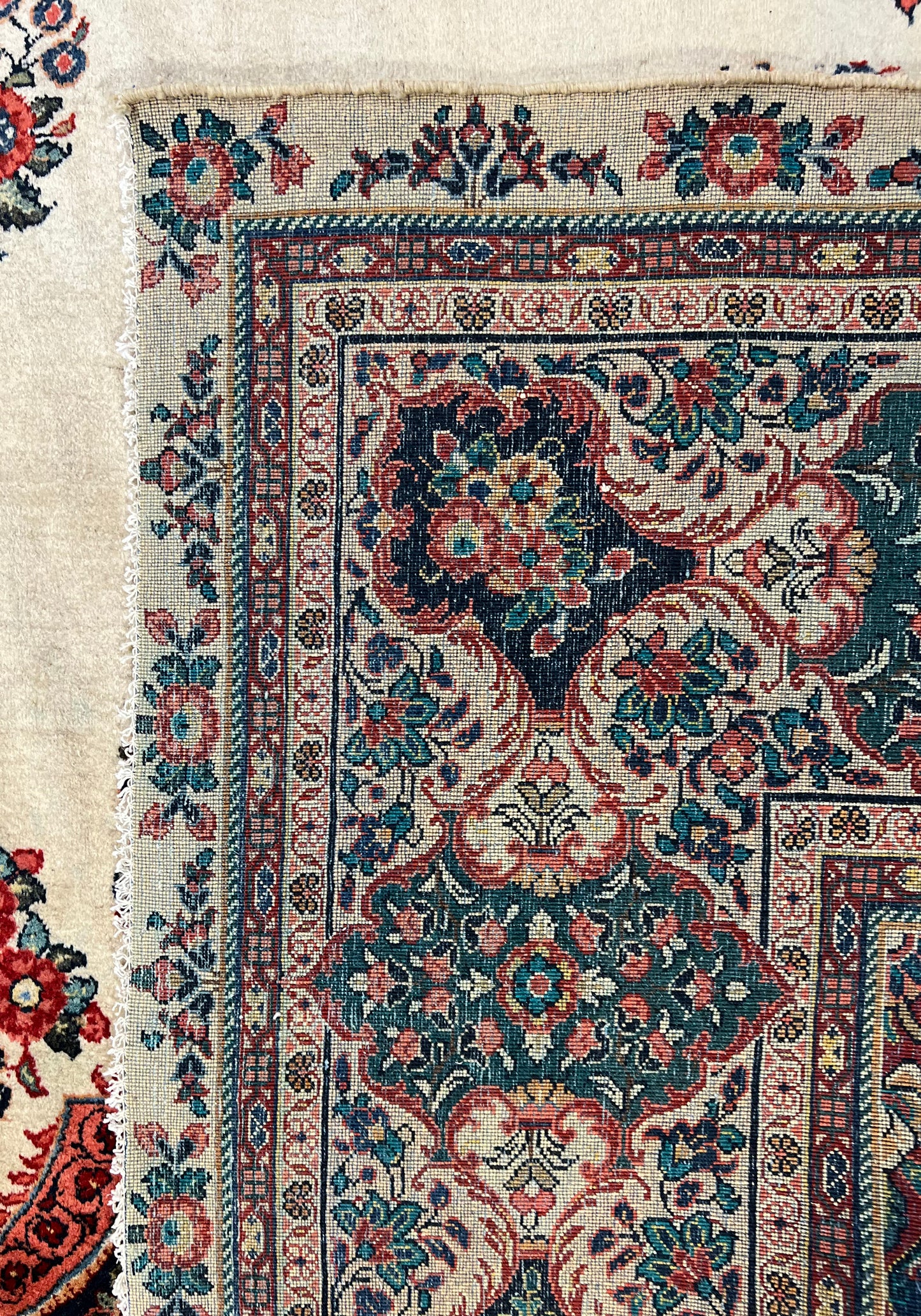Semi-Antique Sarough, circa 1950 13'9" x 10'
Overview
A Brief History of Sarough Carpets
Situated in the province of Markasi near Arak in west-central Iran, the large village of Sarough is an important historic center with an esteemed name in carpet weaving. Carpets from Sarough (also spelled Sarouk, Saruk, Sarug, Sarouq, Saruq) are among the most desirable and decorative Persian carpets. Oriental rugs have been woven in Sarough and its surrounding villages since ancient times. These rugs are mostly marketed through Arak and are sold under different city names such as Mahal, Ferahan (Feraghan), Lylyan, Malayer, Viss, Meshkabad (Mushkabad), Mirabad, Seraband, Mohajaran and Jozan. An antique Sarough area rug produced prior to 1900 is considered to be a masterpiece. Due to the extraordinary quality of craftsmanship and material, it is sought after by museums and private collectors alike. Talented weavers create the Sarough area rug in both village and workshop settings using the Persian knot, although the Turkish knot is seen in antique Saroughs.
Since the 1920s, their design has been influenced by the renowned Ziegler/Zeigler workshops towards European taste preferences. After WWI this shifted to the US market and the American Sarough with red, blue and dughi pink, as dominating colors, was born. Traditional Sarough patterns include curvilinear and geometric layouts, Herati and boteh motifs, medallions in all shape and sizes and a medallion-and-corner design. It is not easy to tell a Sarough area rug from one produced in a neighbouring village because there is not a motif that is totally unique to Sarough. However, the most classic Sarough design usually is that of floral vines with red and navy as predominant colors. The foundation on a Sarough area rug is cotton. Its pile is wool of very high quality although older or antique pieces are blended with silk. Sarough carpets are available in a variety of sizes but are most frequently made in mid to large sizes. These one-of-a-kind masterpieces add elegance and refinement to homes while harmonizing with any decor. To learn more about iranian rugs, visit our Persian Rugs section.
Sources and inspiration: Bérinstain, Valérie, et al. L'art du tapis dans le monde (The art of carpets in the world). Paris: Mengès, 1996. Print.; Jerrehian Jr., Aram K.A. Oriental Rug Primer. Philadelphia: Running Press, 1980. Print.; Herbert, Janice Summers. Oriental Rugs, New York: Macmillan, 1982. Print.; Hackmack, Adolf. Chinese Carpets and Rugs, Rutland and Tokyo: Tuttle, 1980. Print. ; De Moubray, Amicia, and David Black. Carpets for the home, London: Laurence King Publishing, 1999. Print.; Jacobsen, Charles. Oriental Rugs A Complete Guide, Rutland and Tokyo: Tuttle, 1962. Print.; Bashir, S. (n.d.). Personal interview.; Web site sources and dates of consultation vary (to be confirmed). Without prejudice to official usage.
- Choosing a selection results in a full page refresh.
- Opens in a new window.



 Runner Rugs
Runner Rugs 2x3 Area Rugs
2x3 Area Rugs 3x5 Area Rugs
3x5 Area Rugs 4x6 Area Rugs
4x6 Area Rugs 5x7 Area Rugs
5x7 Area Rugs 6x9 Area Rugs
6x9 Area Rugs 8x10 Area Rugs
8x10 Area Rugs 9x12 Area Rugs
9x12 Area Rugs 10x14 Area Rugs
10x14 Area Rugs Round Rugs
Round Rugs Bath Mats
Bath Mats Doormats
Doormats 12x15 Area Rugs
12x15 Area Rugs




















